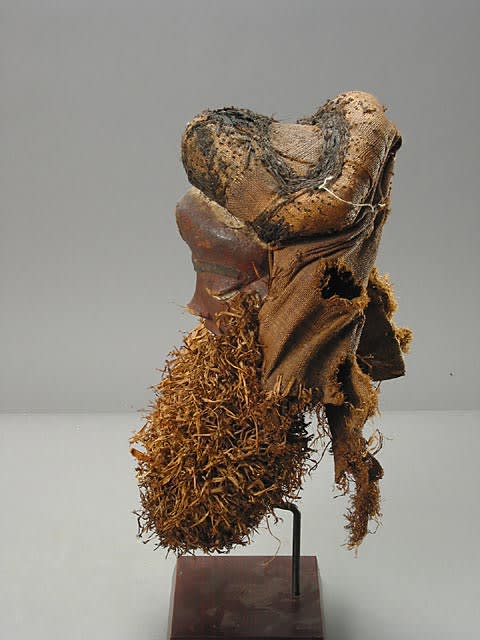Pende Wooden Mask with a Raffia Beard, 20th Century CE
Wood and Mixed Media
8 x 14
PF.4473 (LSO)
Further images
This imposing mask is an exceptional piece, made by the Pende of Gabon and Zaire. The barely-visible long beard denotes that it is a Kiwoyo-Muyombo mask, and was involved in...
This imposing mask is an exceptional piece, made by the Pende of Gabon and Zaire. The barely-visible long beard denotes that it is a Kiwoyo-Muyombo mask, and was involved in masquerades for the commemoration of circumcision and initiation. It is traditionally Western Pende, with downcast eyes, a triangular nose and a small mouth beneath relief brows and a triple vertical keloid scarification on the forehead. The ground is brown/red in colour; the “beard” is decorated with geometric dark and light patterns. The head is surmounted with a large textile hat, the base with a large raffia beard that would effectively conceal the wearer.
The Pende live in the Loango and Kasai River area in what was once Zaire. They have a complex history of interaction with the Lunda Empire and the Tchokwe, and are affiliated with the Yaka and Suku, with which they share a common origin (Angola). They are governed by a loose network of localised chiefs (Djigo) and what essentially amounts to a landed aristocracy. Social structures – and thus most of their artworks – are centred on age groups which are circumcised and enter adulthood together, with what essentially amounts to a gerontocracy through the society. The spiritual welfare of Pende communities is controlled by family heads (usually the eldest maternal uncle of a family – the society is matrilineal) and village diviners. Ancestor spirits (mvumbi) are either good or bad, determined by the manner in which the ancestor died, and can harm the family unless appeased and cared for. Spirits may demand that the holy man make a sculpture, to which offerings are made.
So far as artistic production is concerned, the Pende are divided into Eastern and Western groups, although these divisions are socially artificial and the Pende consider themselves to be a single people. A great deal of Pende art is basically regalia, including ivory mask pendants (Ikhoko), staffs, adzes, cups whistles and much else. Pende figures are rare, and represent ancestors; some female sculptures have also been recovered, and are believed to be maternity figures. There are fifteen mask forms in the Western group, all of which are somewhat similar in possessing downcast eyes, protruding teeth and a triangular nose. This particular piece would have been worn with a large costume that covered the wearer at least down to the waist, and would have been danced in masquerade ceremonies as an imposing elder character (beards are usually associated with older men, which were usually authoritative characters in this gerontocratic society).
This is thus an important piece, as well as being an attractive piece of art in its own right.
The Pende live in the Loango and Kasai River area in what was once Zaire. They have a complex history of interaction with the Lunda Empire and the Tchokwe, and are affiliated with the Yaka and Suku, with which they share a common origin (Angola). They are governed by a loose network of localised chiefs (Djigo) and what essentially amounts to a landed aristocracy. Social structures – and thus most of their artworks – are centred on age groups which are circumcised and enter adulthood together, with what essentially amounts to a gerontocracy through the society. The spiritual welfare of Pende communities is controlled by family heads (usually the eldest maternal uncle of a family – the society is matrilineal) and village diviners. Ancestor spirits (mvumbi) are either good or bad, determined by the manner in which the ancestor died, and can harm the family unless appeased and cared for. Spirits may demand that the holy man make a sculpture, to which offerings are made.
So far as artistic production is concerned, the Pende are divided into Eastern and Western groups, although these divisions are socially artificial and the Pende consider themselves to be a single people. A great deal of Pende art is basically regalia, including ivory mask pendants (Ikhoko), staffs, adzes, cups whistles and much else. Pende figures are rare, and represent ancestors; some female sculptures have also been recovered, and are believed to be maternity figures. There are fifteen mask forms in the Western group, all of which are somewhat similar in possessing downcast eyes, protruding teeth and a triangular nose. This particular piece would have been worn with a large costume that covered the wearer at least down to the waist, and would have been danced in masquerade ceremonies as an imposing elder character (beards are usually associated with older men, which were usually authoritative characters in this gerontocratic society).
This is thus an important piece, as well as being an attractive piece of art in its own right.







